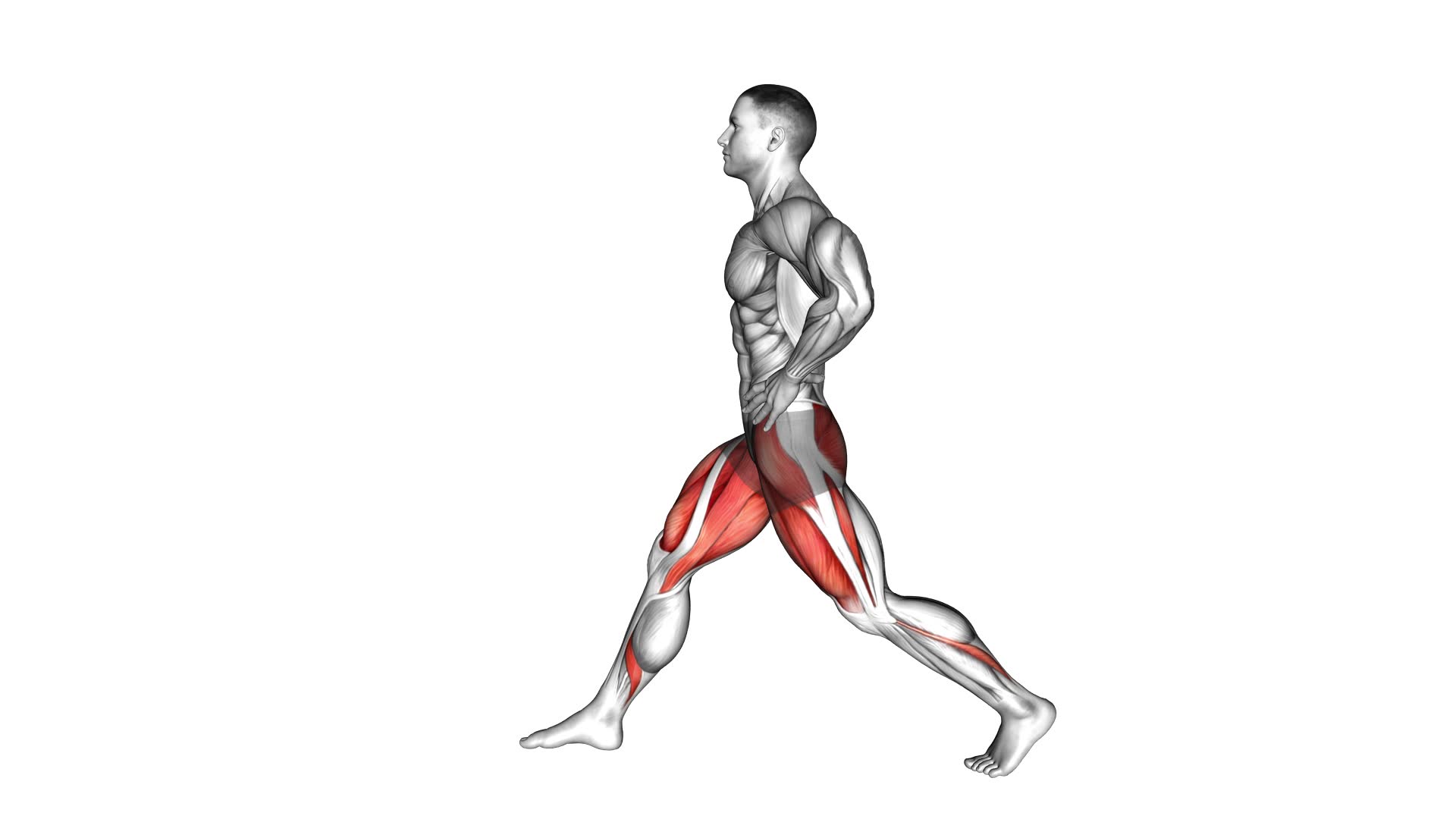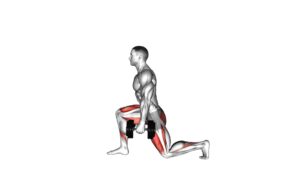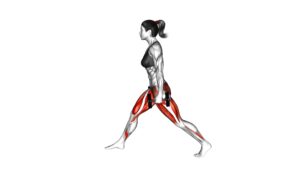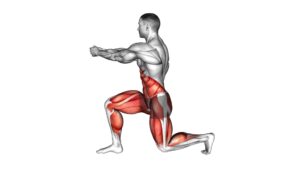Static Lunge – Video Exercise Guide & Tips

Are you looking for an effective lower body exercise to add to your fitness routine? Look no further than the static lunge!
Watch This Exercise Video
This video exercise guide will show you the proper form and technique, as well as variations and progressions to challenge yourself.
Avoid common mistakes and get the most out of your workout with these helpful tips.
Get ready to tone and strengthen your legs with the static lunge. Let's get started!
Key Takeaways
- Static lunges improve balance
- Static lunges increase lower body strength
- Static lunges target quadriceps, hamstrings, and glutes
- Static lunges tone and strengthen the lower body
Benefits of Static Lunges
To reap the benefits of static lunges, incorporate this exercise into your workout routine. Static lunges are an excellent way to improve your balance and increase lower body strength. When you perform a static lunge, you're essentially holding a lunge position without any movement. This exercise primarily targets your quadriceps, hamstrings, and glutes, making it a great option for toning and strengthening your lower body.
One of the key benefits of static lunges is their ability to improve balance. By engaging your core and stabilizing muscles, static lunges help you develop better control over your body's movements. This increased stability not only benefits you during exercise but also in your daily activities, reducing the risk of falls and injuries.
Additionally, static lunges are highly effective in increasing lower body strength. As you hold the lunge position, your muscles are working hard to maintain stability and support your bodyweight. This constant tension builds strength in your quadriceps, hamstrings, and glutes, leading to improved overall lower body strength.
Incorporating static lunges into your workout routine is a simple yet effective way to enhance your balance and strengthen your lower body. Aim to perform 2-3 sets of 10-12 repetitions on each leg, gradually increasing the intensity as you become more comfortable with the exercise. Remember to maintain proper form throughout the movement and listen to your body to prevent any unnecessary strain or injury.
Proper Form and Technique
To perform a static lunge with proper form and technique, there are a few key points to keep in mind.
First, focus on maintaining proper alignment and posture throughout the exercise, keeping your chest lifted and shoulders relaxed.
Second, engage the muscles of your front leg, glutes, and core by pushing through your front heel and squeezing your glutes at the top of the movement.
Finally, be aware of common mistakes to avoid, such as allowing your knee to extend past your toes or leaning too far forward.
Alignment and Posture
Maintain proper alignment and posture throughout the static lunge exercise to maximize its effectiveness and prevent injury. Here are some alignment tips and posture cues to help you achieve the correct form:
- Stand with your feet hip-width apart, toes pointing forward.
- Take a step forward with one foot, keeping your stance wide enough to maintain balance.
- Bend both knees and lower your body, ensuring that your front knee is directly above your ankle.
- Keep your back straight, shoulders relaxed, and gaze forward to maintain a neutral spine.
By following these alignment tips and posture cues, you can ensure that you're engaging the correct muscles and getting the most out of your static lunge exercise.
Now, let's move on to the next section where we'll discuss muscle engagement cues.
Muscle Engagement Cues
To engage the correct muscles and ensure proper form and technique during the static lunge exercise, focus on these muscle engagement cues.
- First, concentrate on activating your glutes and quadriceps. As you lower into the lunge, push through your front heel and drive your hips forward, engaging your glutes.
- Simultaneously, keep your core engaged and your chest lifted to maintain proper body positioning. Avoid letting your front knee go past your toes and make sure your back knee is hovering just above the ground. This will ensure that your quadriceps are properly engaged.
Common Mistakes to Avoid
Avoid these common mistakes to ensure proper form and technique during the static lunge exercise:
- Allowing your front knee to extend beyond your toes: Keep your front knee aligned with your ankle to prevent unnecessary strain on your knee joint.
- Leaning too far forward: Maintain an upright posture throughout the exercise to engage your glutes and quads effectively.
- Neglecting to engage your core: Activate your core muscles by drawing your belly button in towards your spine, which will help stabilize your body.
- Failing to maintain proper alignment: Keep your back straight and shoulders relaxed, avoiding any twisting or leaning to the side.
By avoiding these common mistakes and following proper form and technique, you can maximize the benefits of the static lunge exercise.
Now, let's move on to discussing other common mistakes to avoid.
Common Mistakes to Avoid
You often make common mistakes when performing the static lunge exercise. These mistakes can prevent you from getting the full benefits of the exercise and may even lead to injury.
One common mistake isn't maintaining proper alignment. Make sure your front knee is directly above your ankle and your back knee is hovering just above the ground.
Another mistake is leaning too far forward or backward. Keep your torso upright and engage your core for stability.
Additionally, avoid letting your front knee collapse inward. Instead, push through your heel and engage your glutes to maintain stability.
Lastly, avoid rushing through the exercise. Take your time and focus on proper form and control.
To improve your static lunge, start by practicing in front of a mirror to check your alignment. You can also use a stability ball or a wall for support until you build up strength and balance.
Remember to breathe deeply and engage your muscles throughout the exercise. By avoiding these common mistakes and incorporating these tips, you can perform the static lunge exercise safely and effectively.
Variations and Progressions
When performing the static lunge exercise, there are several variations and progressions that can be incorporated to challenge your muscles and increase the difficulty of the exercise. Here are four variations and progressions you can try:
- Walking Lunges: Instead of staying in one spot, take a step forward with each lunge. This adds an element of balance and coordination to the exercise.
- Jump Lunges: To add an explosive element to the static lunge, try incorporating a jump between lunges. This increases the cardiovascular challenge and engages more muscles in your lower body.
- Weighted Lunges: Hold a dumbbell or kettlebell in each hand to add resistance to the exercise. This increases the strength-building benefits and further challenges your muscles.
- Elevated Lunges: Place your front foot on a step or bench while performing the static lunge. This increases the range of motion and activates different muscle fibers in your legs.
Tips for a More Effective Workout
To ensure a more effective workout, it's important to focus on proper form techniques and target the specific muscle groups during a static lunge. Maintaining a straight back, engaging your core, and keeping your front knee in line with your ankle will help prevent injury and maximize the benefits of this exercise.
Proper Form Techniques
Improve your workout effectiveness with proper form techniques when performing the static lunge exercise. Here are some alignment cues and exercise modifications to help you get the most out of this exercise:
Alignment cues:
- Stand with your feet hip-width apart.
- Step forward with one foot, keeping your knee directly above your ankle.
- Keep your back straight and engage your core.
- Lower your body by bending both knees, aiming to bring your back knee close to the ground.
Exercise modifications:
- If you have knee issues, perform a reverse lunge instead by stepping back instead of forward.
- Hold onto a chair or wall for balance if needed.
- Add weights to increase the intensity.
Targeted Muscle Groups
Maximize your workout by targeting specific muscle groups with the static lunge exercise. The static lunge primarily activates the quadriceps, hamstrings, and glutes.
To increase muscle activation in the quadriceps, focus on pushing through your front heel as you return to the starting position.
For greater hamstring engagement, make sure to keep your chest lifted and lean your torso slightly forward.
To further activate the glutes, squeeze them at the top of the lunge.
Additionally, you can modify the exercise to target different muscle groups. To emphasize the inner thighs, perform a static lunge with your feet wider apart. To target the outer thighs and glutes, step out to the side instead of forward.
Incorporating Static Lunges Into Your Fitness Routine
Add static lunges to your fitness routine for stronger legs and improved balance. Static lunges are a great exercise that targets your quadriceps, hamstrings, glutes, and calves. They also provide a number of benefits for runners, including improved stability and increased power in your stride.
Here's how you can incorporate static lunges into your workout:
- Start with proper form: Stand tall with your feet hip-width apart, take a step forward with one foot, and lower your body until both knees are bent at a 90-degree angle. Keep your chest lifted and your core engaged.
- Increase the challenge: Hold dumbbells in your hands or wear a weighted vest to add resistance and make the exercise more challenging.
- Modify the exercise: If you have knee or joint issues, try performing static lunges with your back foot elevated on a step or platform to reduce the strain on your joints.
- Mix it up: Include static lunges in a circuit workout or alternate them with other leg exercises like squats or lunges to keep your routine varied and engaging.
Frequently Asked Questions
How Many Sets and Repetitions Should I Do for Static Lunges?
To determine the number of sets and repetitions for static lunges, consider your fitness level and goals.
If you're a beginner, start with 2-3 sets of 10-12 repetitions per leg.
As you progress, increase the intensity by adding more sets or repetitions. For advanced fitness levels, aim for 3-4 sets of 12-15 repetitions per leg.
Remember, modifying the exercises and gradually increasing the challenge can help you achieve better results.
Adding static lunges to your workout routine can improve lower body strength, balance, and stability.
Can I Do Static Lunges Every Day?
Yes, you can do static lunges every day. Incorporating static lunges into your workout routine has many benefits, such as improving lower body strength, balance, and flexibility.
To add more challenge, you can try different variations of static lunges, like adding weights or performing them on an unstable surface.
Remember to warm up properly and listen to your body to avoid overtraining or injury.
What Muscles Do Static Lunges Target?
Static lunges target multiple muscles in your lower body, including the quadriceps, hamstrings, glutes, and calves. By performing this exercise regularly, you can strengthen these muscles, improve your balance, and increase your overall lower body stability.
The benefits of static lunges extend beyond muscle toning, as they also help improve your posture and enhance your athletic performance.
Can I Use Weights While Doing Static Lunges?
Yes, you can definitely use weights while doing static lunges. Adding dumbbells to your static lunges can increase the intensity and challenge your muscles even more.
To perform weighted static lunges, hold a dumbbell in each hand and maintain proper form throughout the exercise. Keep your back straight, chest up, and step forward into a lunge position.
Make sure your front knee stays directly above your ankle and lower your back knee towards the ground.
Are Static Lunges Suitable for Beginners?
Static lunges are a great exercise for beginners. They can be modified to suit your fitness level and help you build strength and stability in your legs.
Incorporating static lunges into your workout routine has many benefits, such as improving balance, toning your leg muscles, and increasing flexibility.
Conclusion
Incorporating static lunges into your fitness routine can greatly benefit your lower body strength and stability. By maintaining proper form and technique, you can avoid common mistakes and maximize the effectiveness of this exercise.
With variations and progressions, you can challenge yourself and continue to see improvements over time. Remember to always listen to your body and consult a professional if you have any concerns or questions.
Start incorporating static lunges into your workouts and enjoy the benefits they bring to your fitness journey.

Author
Years ago, the spark of my life’s passion ignited in my mind the moment I stepped into the local gym for the first time. The inaugural bead of perspiration, the initial endeavor, the very first surge of endorphins, and a sense of pride that washed over me post-workout marked the beginning of my deep-seated interest in strength sports, fitness, and sports nutrition. This very curiosity blossomed rapidly into a profound fascination, propelling me to earn a Master’s degree in Physical Education from the Academy of Physical Education in Krakow, followed by a Sports Manager diploma from the Jagiellonian University. My journey of growth led me to gain more specialized qualifications, such as being a certified personal trainer with a focus on sports dietetics, a lifeguard, and an instructor for wellness and corrective gymnastics. Theoretical knowledge paired seamlessly with practical experience, reinforcing my belief that the transformation of individuals under my guidance was also a reflection of my personal growth. This belief holds true even today. Each day, I strive to push the boundaries and explore new realms. These realms gently elevate me to greater heights. The unique combination of passion for my field and the continuous quest for growth fuels my drive to break new ground.







